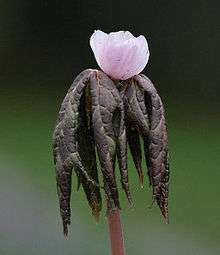Sinopodophyllum
| Himalayan mayapple 桃儿七 tao er qi | |
|---|---|
 | |
| flower and leaves | |
| Scientific classification | |
| Kingdom: | Plantae |
| (unranked): | Angiosperms |
| (unranked): | Eudicots |
| Order: | Ranunculales |
| Family: | Berberidaceae |
| Genus: | Sinopodophyllum T.S.Ying |
| Binomial name | |
| Sinopodophyllum hexandrum (Royle) T.S.Ying | |
| Synonyms[1] | |
| |
Sinopodophyllum is an herbaceous perennial plant in the family Berberidaceae, described as a genus 1979.[2][3] It includes only one known species, Sinopodophyllum hexandrum, native to Afghanistan, Bhutan, northern India, Kashmir, Nepal, Pakistan, and western China (Gansu, Qinghai, Shaanxi, Sichuan, Tibet, Yunnan).[4] Common names include Himalayan mayapple[5] and Indian may apple.
Description
Sinopodophyllum hexandrum is low to the ground with glossy green, drooping, lobed leaves on its few stiff branches, and it bears a pale pink flower and bright red-orange bulbous fruit. The ornamental appearance of the plant make it a desirable addition to woodland-type gardens. It can be propagated by seed or by dividing the rhizome. It is very tolerant of cold temperatures, as would be expected of a Himalayan plant, but it does not tolerate dry conditions. Its name in Hindi and Ayurveda is bantrapushi or Giriparpat.[6]
The plant is poisonous. The rhizome of the plant contains a resin, known generally and commercially as Indian Podophyllum Resin, which can be processed to extract podophyllin (podophyllotoxin), a neurotoxin. It is used medicinally to treat genital warts.[7] Rhizomes contain up to 15% podophyllin.[8]
Distribution
The plant is reasonably abundant in the Great Himalayan National Park of Himachal Pradesh.[9] In the fringes of the Valley of Flowers National Park the study conducted by C.P. Kala shows some scattered population of this important species, locally called as 'ban kakdi'. Here its density is about 0.98 individuals per meter square. It grows across the Indian Himalayan region.[10]
Harvesting
Harvesting from the wild is becoming unsustainable;[11][12][13] over-exploitation for medicinal plants and grazing have resulted in its current IUCN endangered listing.[11][14][14] In India, the main source of the plant, wild harvesting is (2014) illegal under CITES.[11]
 Close-up of single leaf.
Close-up of single leaf. The approximately 5 cm long ripe fruit.
The approximately 5 cm long ripe fruit.- Flowers
- Some fruits of a >20-year-old plant
References
- ↑ The Plant List, Sinopodophyllum hexandrum (Royle) T.S.Ying
- ↑ Ying, Tsun Shen. 1979. Acta Phytotaxonomica Sinica 17(1): 15–16
- ↑ Tropicos, Sinopodophyllum T.S. Ying
- ↑ Flora of China Vol. 19 Page 783 桃儿七 tao er qi Sinopodophyllum hexandrum (Royle) T. S. Ying in C. Y. Wu
- ↑ "Podophyllum hexandrum". Natural Resources Conservation Service PLANTS Database. USDA. Retrieved 9 October 2015.
- ↑ Himalayan Voices
- ↑ "Podophyllotoxin (Podophyllotoxin 0.5% solution)". NHS choices. National Health Service (UK). Retrieved 14 December 2014.
- ↑ Sharma, V. (2013). Part based HPLC-PDA quantification of podophyllotoxin in populations of Podophyllum hexandrum Royle “Indian Mayapple” from higher altitude Himalayas. Journal of Medicinal Plants Studies, 1, 176–183.
- ↑ Kala, Chandra Prakash (2003). Medicinal Plants of Indian Trans Himalaya. Dehradun: Bishan Singh Mahendra Pal Singh. p. 200.
- ↑ Kala, Chandra Prakash (2005). "Indigenous uses, population density and conservation of threatened medicinal plants in the protected areas of Indian Himalaya.". Conservation Biology. 19 (2): 368–378. doi:10.1111/j.1523-1739.2005.00602.x.
- 1 2 3 Chaurasia, O., & Ballabh, B. (2012). Podophyllum L: An endergered and anticancerous medicinal plant–An overview. Indian Journal Traditional of Traditional Knowledge, 11, 234–241. http://nopr.niscair.res.in/handle/123456789/13851
- ↑ Podophyllum peltatum L. (May-apple). Agriculture and Agri-Food Canada (AAFC)(2012). http://www.agr.gc.ca/eng/science-and-innovation/science-publications-and-resources/resources/canadian-medicinal-crops/medicinal-crops/podophyllum-peltatum-l-may-apple/?id=1301436227464
- ↑ Rawal, D. S., Sijapati, J., Rana, N., Rana, P., Giri, A., & Shrestha, S. (2009). Some high value medicinal plants of Khumbum region Nepal, 10, 73–82.
- 1 2 Ghimire, S. K., Mckey, D., & Aumeeruddy-Thomas, Y. (2006). Himalayan medicinal plant diversity in an ecologically complex high altitude anthropogenic landscape, Dolpo, Nepal. Environmental Conservation, 33, 1. doi:10.1017/S0376892906002943
| Wikispecies has information related to: Sinopodophyllum |
| Wikimedia Commons has media related to Sinopodophyllum. |